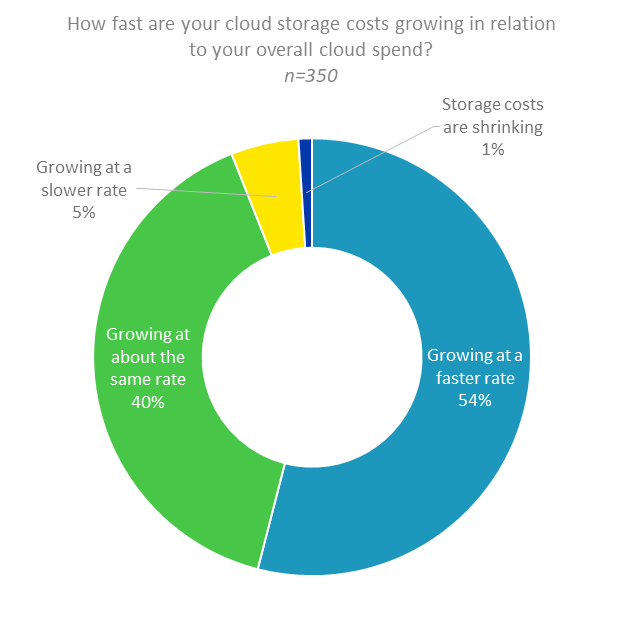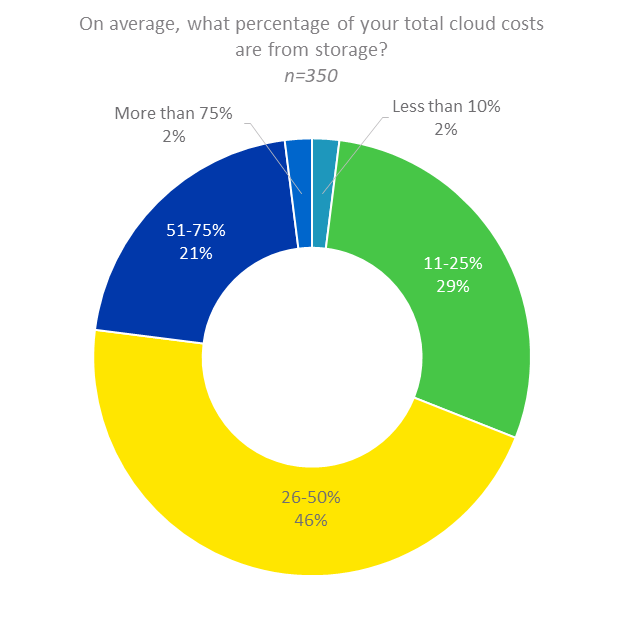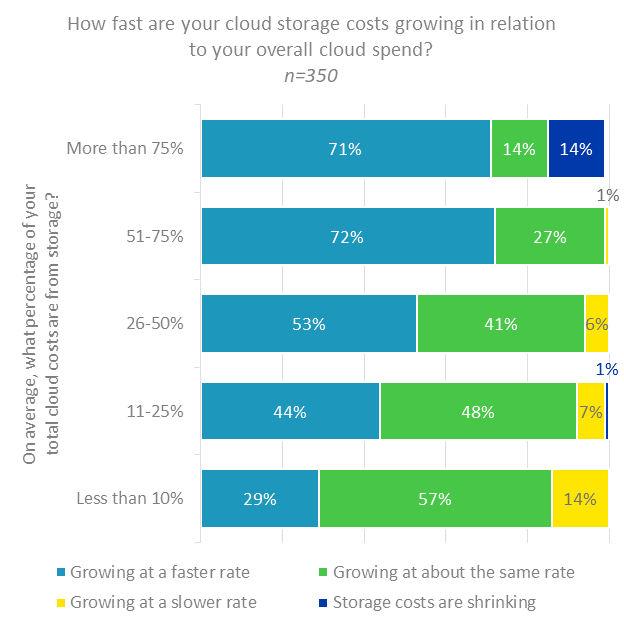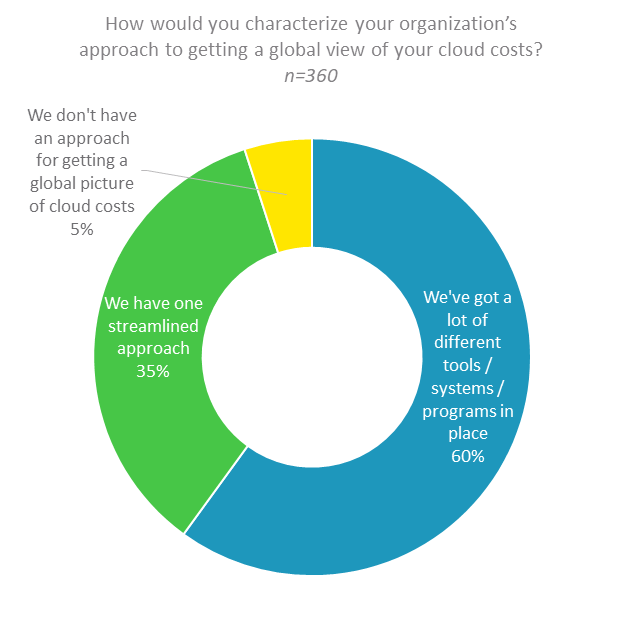Too often, when organizations migrate workloads to the cloud or build new cloud-native applications, they don’t really think about storage. The cloud provider takes care of all that, right? Well, yes and no. There are cost implications to cloud storage that many don’t adequately anticipate—until they get the bill, that is. According to our latest research, cloud storage costs are rising across the board, and over half of companies are seeing their storage spend grow faster than their overall cloud costs.
Cloud storage costs are a growing problem
Our survey found that cloud storage costs are growing for 94% of respondents. But what’s particularly notable is that for more than half (54%), those costs are growing at a faster rate than their overall cloud spend. Gartner predicts that worldwide end-user spending on public cloud services will grow 20.7% in 2023, which is higher than the 18.8% forecast for 2022. If the storage portion of those costs is rising faster than that, it’s quite an eye-popping increase.

Of course, it’s essential to understand how much of the overall cloud spend is for storage. After all, if storage represents one-tenth of one percent, it’s probably not worth worrying about. Alas, this is not the case. Only 2% of respondents reported that less than 10% of their total cloud costs are from storage. Indeed, 59% said that more than one-quarter of their total cloud costs are from storage. So, the storage costs growth trend is concerning.

Furthermore, as the percentage of cloud costs allocated to storage increases, it is more likely that those costs are growing faster than other cloud costs. Of the organizations with more than half of their cloud spend going to storage, 71–72% said that those costs are growing at a faster rate, compared to only 29% of those with the least amount of cloud storage spend.

Why are cloud storage costs so hard to contain?
Clearly, cloud does have a storage problem. But why? There are several factors that come into play.
Complex pricing leads to unpredictable spend
Understanding the cost of on-premises storage is relatively straightforward. In addition to the hardware cost, you should also consider how much you spend on physical space and power consumption. These are easy calculations that give you an accurate picture of your cloud storage costs now and over time. There are many good reasons to move at least some storage to the cloud, but one of the trade-offs is that pricing is complex, making it difficult to understand and predict those costs. Many cloud service providers (CSPs) charge various rates and fees. You may have a per-gigabyte-per-month storage rate, on top of which there could be access or processing fees as well as data transfer (aka data ingress and egress) charges. And the specifics of all these cost layers will vary depending on type of storage, region, service tier, volume discount, and other factors. It’s worth noting that while data ingress—moving data into the cloud—is often free, data egress can be very expensive. If you’re moving a lot of data around a large organization, these charges can be hard to spot and rack up big bills.
Agility can create storage waste
One of the significant advantages of the cloud is that you can use the resources you need in the moment you need them. This agility is great for innovation. Need a new instance? A few clicks, and it’s done. It’s just as simple to terminate an instance you no longer need with any storage associated with that instance—except it’s also easy to forget to take that last step. In some cases, terminating an instance will, by default, terminate the associated storage. But this isn’t always the case and could lead to orphaned storage that you continue to pay for, needlessly adding hefty charges to your cloud bill.
The wrong cloud storage service is selected
Cloud storage admins and architects often don’t have data on the best service to use, so they have to rely on their gut, or they simply default to the standard storage services. This isn’t surprising, given the abundance of options out there. For example, AWS S3 storage comes in several flavors, including S3 Standard, S3 Intelligent Tiering, S3 Glacier Instant Retrieval, and S3 Glacier Deep Archive. That’s a lot of choices to sort through. And if you don’t know that with Glacier, frequent data access can result in higher costs, your storage could end up taking an unexpectedly large bite out of your budget. This isn’t just an AWS challenge; other CSPs have similar slates of storage offerings. Most companies typically don’t evaluate storage costs unless (until) they start to skyrocket, but the bottom line is that optimizing cloud storage costs with the right storage cloud services can forestall unwanted spending increases, and even help decrease costs.
It’s difficult to understand cloud costs in general
Part of the challenge isn’t storage-specific. Enterprises struggle to understand all of their cloud costs. In our previous State of Multi-Cloud Management survey, we found that 65% of respondents lack a single, streamlined approach to getting a global view of their cloud costs. Most (60%) are cobbling together cost information from multiple tools, systems, and processes, which is error-prone and likely to have gaps. And 5% aren’t even trying to get a global view of their cloud costs.

Control your cloud storage costs with Virtana
The good news is that you can address these challenges, and Virtana can help. We may be the premier hybrid cloud infrastructure management platform today, but we know storage. From our heritage monitoring big-iron SAN infrastructures through our evolution into infrastructure performance monitoring and hybrid cloud performance, cost, and capacity management, we bring unmatched storage expertise to our solutions. Virtana Cloud Cost Management, part of the Virtana Platform, enables you to demystify your cloud costs, proactively identify wasted resources—including storage blocks that are no longer attached to a compute instance or are attached to a stopped instance—and improve your cloud resource planning. Try it for free
Get the survey report: The State of Hybrid Cloud Storage
Radically simplify cloud cost management: Try Virtana Cloud Cost Management for free

Jon Cyr
VP of Product Management, Virtana




